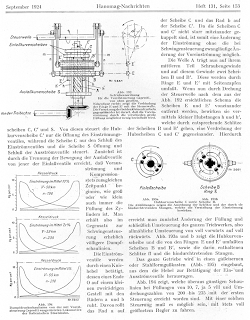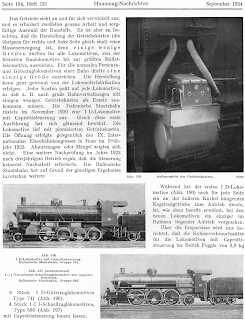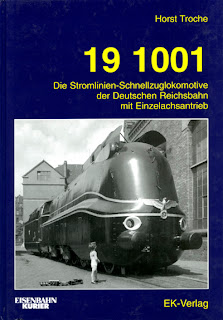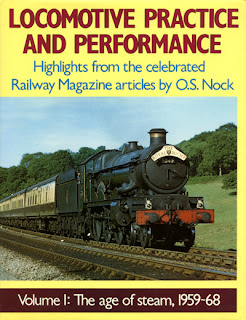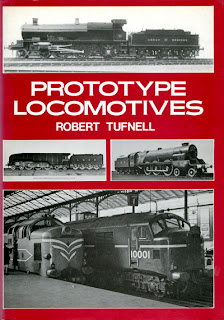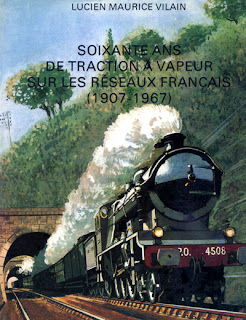Metropolitan-Vickers (electrical parts) and Metropolitan-Vickers - - Beyer Peacock at Stockton-on-Tees (mechanical parts) supplied 24 3000V electric locomotives to two railways in Brazil in 1952-1953. The following pages are copied from Metrovick brochure SP 7597/3 printed in 1957.
Builder's numbers for these locomotives were
RMV 901-914 Metrovick 732-745
RVPSC 2000-2009 Metrovick 772-781
These locomotives were fairly small, weight 49.2 tons, one hour rating 1080 hp, tractive effort 6960 kg (15300 lb) at 41.7 km/h (25.9 mph). Continuos rating was 900hp, t.e. 5480 kg (12050 lb) at 44.0 km/h (27.4 mph). They were required to start a train of 130 tonnes on a gradient of 30‰ and 360 tonnes on gradient of 10 ‰. On the level 360-tonne train should reach a speed of 68 km/h (42 mph).
Pages 7, 8 and 13 show performance curves, page 18 the driver's cabin.
At this time I have no details of actual performance in service.
RMV = Rêde Mineira de Viação
RVPSC = Rêde de Viação Parana-Santa Catarina
Both railways operate on metre gauge, max gradients are 30‰, and minimum radius of curves is 100m.
2013-06-22
2013-06-11
VR Finland steam locomotive load tables (1936)
Load tables and performance curves for Finnish locomotives may not be too common outside Finland. This time our booklet is Kiertokirje N:o 10/2187, syyskuun 21 päivänä 1936 (September 21, 1936). It has 30 pages of text, 125x175mm, no illustrations. It gives load tables to steam locomotives at different gradients and list max gradients on every railway line and on main industrial or harbour branches. Our samples show load tables for 10‰ (1 in 100) and 12.5‰ (1 in 87).
Naturally the 1885 classification is used as the new one was introduced only in October 1942. Conversion from the old to the new classes is given below:
D1 = Vr2
G1, 2, 4 = Sk1
G1, 6, 9 = Sk2 (note G1, some became Sk1, some Sk2 and many were already withdrawn by 1942)
G3, 5, 10, 11 = Sk3
G7 = Sk4
G8 = Sk6
G12 = Sk5
H1, 2 = Hk1
H3 = Hk2
H5 = Hk3 (all H4 and three of H3 were rebuilt as H5)
H6 = Hk5
H7 = Hv4
H8 = Hv1
H9 = Hv2, Hv3 (Hv2 3-axle tender and Hv3 4-axle tender)
I1 = Vk1
I3 = Vk3
K1 = Tk1
K2 = Tk2
K3 = Tv1
K4 = Tv2
K5 = Tk3
L1 = Vr1
N1 = Pr1
O1 = Vr3
Columns 1-3 in the tables represent:
1 = always (winter and summer)
2 = no snow on rails, temperature higher than 0C
3 = on discretion of the driver
Naturally the 1885 classification is used as the new one was introduced only in October 1942. Conversion from the old to the new classes is given below:
D1 = Vr2
G1, 2, 4 = Sk1
G1, 6, 9 = Sk2 (note G1, some became Sk1, some Sk2 and many were already withdrawn by 1942)
G3, 5, 10, 11 = Sk3
G7 = Sk4
G8 = Sk6
G12 = Sk5
H1, 2 = Hk1
H3 = Hk2
H5 = Hk3 (all H4 and three of H3 were rebuilt as H5)
H6 = Hk5
H7 = Hv4
H8 = Hv1
H9 = Hv2, Hv3 (Hv2 3-axle tender and Hv3 4-axle tender)
I1 = Vk1
I3 = Vk3
K1 = Tk1
K2 = Tk2
K3 = Tv1
K4 = Tv2
K5 = Tk3
L1 = Vr1
N1 = Pr1
O1 = Vr3
Columns 1-3 in the tables represent:
1 = always (winter and summer)
2 = no snow on rails, temperature higher than 0C
3 = on discretion of the driver
2013-06-08
Kálmán Kandó electric locomotives (MÁV Hungary) (part 1)
Finnish railphoto & discussion site Vaunut.org had a discussion about Kálmán Kandó (1869.07.10-1931.01.13) and his three-phase locomotives and phase converter after this archive photo of his early freight locomotive in Hungary.
http://vaunut.org/kuva/82548 (and also under this photo http://vaunut.org/kuva/81950 )
This input gives some further documents to these questions. This old article by Dr.-Ing. Paul Müller was published in 1936 in the Ergänzungsheft to the German monthly magazine Elektrische Bahnen. I separated the text and images from pages 62 to 65 in order to show these line drawings bigger. In reality the lay-out in the magazine is nice and clear.
http://vaunut.org/kuva/82548 (and also under this photo http://vaunut.org/kuva/81950 )
This input gives some further documents to these questions. This old article by Dr.-Ing. Paul Müller was published in 1936 in the Ergänzungsheft to the German monthly magazine Elektrische Bahnen. I separated the text and images from pages 62 to 65 in order to show these line drawings bigger. In reality the lay-out in the magazine is nice and clear.
Caprotti valve gear (part 1) (Italy)
There does not seem to be much information regarding the early years of Caprotti valve gear. Wikipedia in English says "The Caprotti valve gear is a type of steam engine valve gear invented in the early 1920s by Italian architect and engineer Arturo Caprotti. It uses camshafts and poppet valves rather than piston valves" Italian Wikipedia give a little more information, but I cannot translate it into English. Arturo Caprotti lived 1881.03.22-1938.02.08.
My first contribution to Caprotti is a copy of an article in Hanomag Nachrichten, issue 131, September 1924 and a Caprotti leaflet of 1924, which I found inside this magazine. Both are in German, but hopefully the illustrations give some idea even to those who do not read German. Abb. 190 shows the first locomotive (FS 741.001) with Caprotti gear. Abb. 196 shows another class 741 and Abb. 197 the express locomotive, FS class 686. Abb. 198 is probably the main reason for this article, as it shows a Hanomah-built tank locomotive, obviously the first Caprotti locomotive built by them.
The Caprotti leaflet tells that class 686 locomotives are mainly used from Firenze (Florence) to Roma (Rome) ans Livorno. Class 741 freight locomotives are used from Foggia to Napoli (Naples), Termoli and Bari, except 741.007 which at the time was used in trials between Bologna and Milano (Milan). Page two gives the dates in use with Caprotti gear and the distance covered by each locomotive. Note 1) says "the first locomotive" and note 2) exhibit in Milan Trade Fair.
My first contribution to Caprotti is a copy of an article in Hanomag Nachrichten, issue 131, September 1924 and a Caprotti leaflet of 1924, which I found inside this magazine. Both are in German, but hopefully the illustrations give some idea even to those who do not read German. Abb. 190 shows the first locomotive (FS 741.001) with Caprotti gear. Abb. 196 shows another class 741 and Abb. 197 the express locomotive, FS class 686. Abb. 198 is probably the main reason for this article, as it shows a Hanomah-built tank locomotive, obviously the first Caprotti locomotive built by them.
The Caprotti leaflet tells that class 686 locomotives are mainly used from Firenze (Florence) to Roma (Rome) ans Livorno. Class 741 freight locomotives are used from Foggia to Napoli (Naples), Termoli and Bari, except 741.007 which at the time was used in trials between Bologna and Milano (Milan). Page two gives the dates in use with Caprotti gear and the distance covered by each locomotive. Note 1) says "the first locomotive" and note 2) exhibit in Milan Trade Fair.
2013-06-07
Book review 2: Japan
Book review 2:
A Hundred Years of Progress in JNR Rolling Stock. Published circa 1973. This is entirely in Japanese with only names of main chapters also in English. I cannot read this one and include it only to show JNR class C62, which is claimed to have the speed record for narrow gauge steam locomotives, 80 mph (129 km/h), attained on 15 Dec 1954. Book review 1 gave SAR 16E as still faster. We will check the evidence later .
Otherwise, this heavy book is quite handy if one needs to know what any Japanese locomotive or railcar looked. There are 10+494 pages, size 190x255 mm and something like 1500 to 2000 photos. I did not count them this time. Steam locomotive section shows one basic photo of each class, the sample page 82 is quite typical. Other sections show also details, like engines, bogies, seating arrangements and like. The first pages are unnumbered, steam locomotives are on pages 1-84, electric locomotives p. 85-140, diesel locomotives p. 141-168, passenger cars p. 169-260, freight cars p. 261-320, electric railcars p. 321-420, diesel railcars 421-468 and Shinkansen on p. 469-492.
I did not not find any on sale just now (using the name in English).
Book review 1: South Africa
I must begin with simple reviews until I learn to use this site.
Book review 1:
The first book is South Africa - Last Stronghold of Steam. It was published by South African Government in 1978 and distributed free of charge by South African Railways. There is no mention of the writer of the text. Two photos are acknowledged to H.L. Pivnic and the others are probably SAR official photos. There are 68 pages plus card covers, size 215x135mm. All photos (25 b/w) are full page opposite to the text relating to the same class. The last 10 pages give suggestions to specimen tours. The cover image in my copy is not sitting straight, no bad scanning ;)
25 classes are included in this booklet (12AR, 14R, 14CR, 15AR, 15BR, 15CB, 15F, 16CR, 16DA, 16E, 19B, 19C, 19D, 23, 24, 25, 25NC, S, S1, S2, GCA, GEA, GF, GL, and GMA/M & GO). Text for only three classes give any performance related information: GL (4-8-2+2-8-4 or 2D1-1D2 Garratt), 19C (4-8-2 or 2D1) and 16E (4-6-2 or 2C1). Sample page shows class GL, all pages have the same general design.
NBL made 19C had 4'6" (1372 mm) driving wheels, two 21x26" (533x660 mm) cylinders and it was fitted with R.C. Poppet valve gear, which soon started to give trouble. But 19C No. 2463 on test between Wellington and Cape Town in 1935 put up a remarkable performance during which a speed of 67 mph (108 km/h) was attained. Net time start-to-stop from Wellington to Cape Town with a load of 131 tons (133.1 t) was 50 1/2 minutes [for 45 miles or 72 km].
Henschel made 16E had 6'0" (1829 mm) driving wheels, two 21x26" (533x660 mm) cylinders and poppet valves. The text says that the driving wheels were the largest ever used on a 3ft 6in (1067 mm) gauge railway anywhere in the world. We must check that claim later. On test 16E No. 854 attained a speed of 85 mph (136.8 km/h) with a trailing load of 350 tons (355.6 t). At the time, "to avoid public concern" the speed was quoted at just around 70 mph (112.6 km/h). But the full potential of 16E could not be realised as there was a general speed limit of 55 mph (88.5 km/h), which could be achieved by many other classes, too.
Now, this claim (official claim as this is a SAR publication) conflicts with information given in Wikipedia, see JNR (Japan) class C62 or Speed records, which both give 80 mph (129 km/h) for that locomotive and claim it to be the highest speed attained by a steam locomotive on any narrow gauge railway (attained 1954-12-15). Later, when I learn to use this blog better, we will see what other more technical publications say about this matter.
This booklet is easy to find from numerous sellers on the net.
A picture of JNR class C62 is shown in the second short review.
2013-06-05
Contents of this blog
Book reviews, locomotive brochures, my own logs and other previously unpublished logs 1862-2013.
I will review books from my own collection giving at least some information on trials, performance in service, speed/power diagrams, load tables or logs. Below are some sample covers to give some idea of what kind of publications will be reviewed. They are not necessarily new, some of them are very old and many are out-of-print.
Some of my own logs are shown at http://poelhoe.blogit.fi/ It is in Finnish, look at words Nopeustaulukoita, nopeustaulukot etc. There are several pages or sections with these words.
By the way, bear with my English. It is not my first or second language.
Sample covers of forthcoming blogs:
I will review books from my own collection giving at least some information on trials, performance in service, speed/power diagrams, load tables or logs. Below are some sample covers to give some idea of what kind of publications will be reviewed. They are not necessarily new, some of them are very old and many are out-of-print.
Some of my own logs are shown at http://poelhoe.blogit.fi/ It is in Finnish, look at words Nopeustaulukoita, nopeustaulukot etc. There are several pages or sections with these words.
By the way, bear with my English. It is not my first or second language.
Sample covers of forthcoming blogs:
Subscribe to:
Posts (Atom)











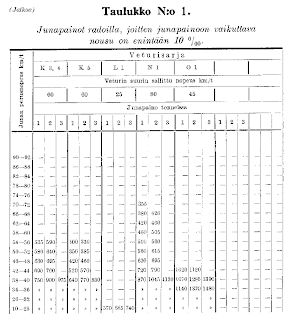












.jpg)

